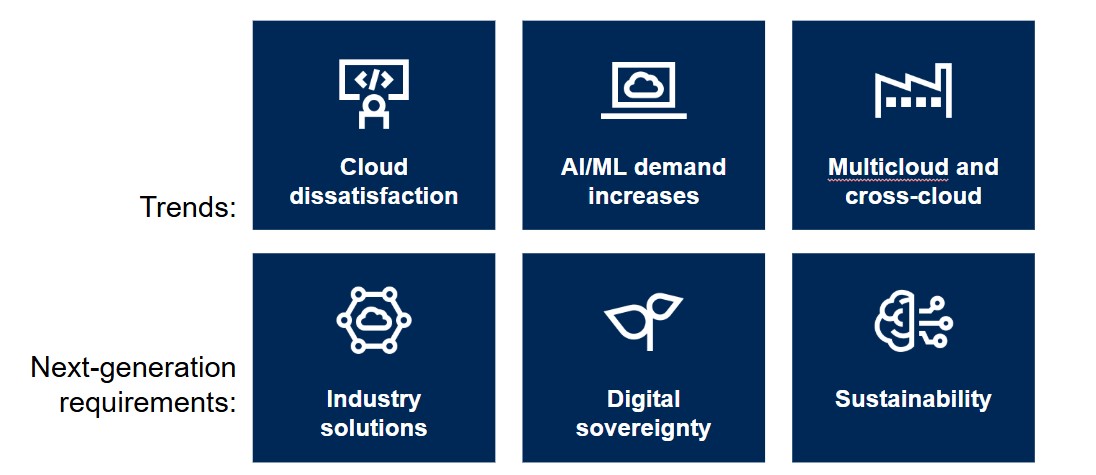Gartner identifies 6 major trends that will change the cloud game in the next 4 years – AI, multi-cloud, and Digital Sovereignty are on the rise

These trends are accelerating the transformation of how cloud has evolved from a technology enabler to a business enabler and imperative for most organizations. Over the next few years, cloud will continue to unlock new business models, provide competitive advantages, and provide a better way to achieve business goals, said Joe Rogus, Gartner Consulting Director.
Gartner has identified six trends that will shape the future of cloud, resulting in new ways of working that are digital in nature and have a transformative impact (see Figure 1):

Source: Gartner (May 2025)
Trend 1: Cloud Dissatisfaction
Cloud adoption continues to grow, but it's not without success. Gartner predicts that 25% of organizations will experience significant cloud adoption dissatisfaction by 2028 due to unrealistic expectations, inappropriate adoption, and/or uncontrollable costs.
To remain competitive, organizations need to have a clear cloud strategy and an effective implementation plan. Gartner states that organizations that successfully address issues with an upfront strategic focus will see fewer cloud disruption incidents by 2029.
Trend 2: Increased demand for AI/ML technologies
The demand for AI/ML is growing rapidly, with hyperscalers at the core of this growth. They will drive this transformation by embedding compute resources natively into IT infrastructure to facilitate collaboration with vendors and users, and leveraging real and synthetic data to train AI models. Gartner predicts that by 2029, half (50%) of cloud compute resources will be dedicated to AI, up from less than 10% today.
"All this points to a fivefold increase in AI-related cloud workloads by 2029.
Now is the time for organizations to evaluate whether their data center and cloud strategies are ready to handle the increasing demand for AI & ML. In many cases, AI may need to be brought to where the data is to support this growth, Rogus added.
Trend 3: Multicloud and Cross Cloud
Many organizations adopting multi-cloud architectures find connectivity to and between providers challenging. A lack of interoperability across environments slows cloud adoption, with Gartner predicting that by 2029, more than half (50%) of organizations will not achieve the results they expected from their multi-cloud deployments.
Gartner recommends identifying specific use cases and planning for distributed apps and distributed data deployed within an organization that may benefit from adopting a cross-cloud deployment model, which enables interoperability across cloud platforms, including on-premises and colocation cloud deployments.
Trend 4: Industry Solutions
Industry-specific cloud platform adoption is on the rise, with a growing number of providers offering solutions that meet specific business outcomes and help scale digital projects. Gartner predicts that by 2029, more than half (50%) of organizations will use Industry Cloud Platforms to accelerate business projects.
Gartner also recommends that organizations adopt industrial cloud platforms as a strategy to add new capabilities to a broader range of IT products and services, rather than a complete replacement, which will help organizations avoid technical debt, drive innovation and create business value.
Trend 5: Digital Sovereignty
As AI adoption, stricter privacy regulations and geopolitical tensions drive demand for Sovereign Cloud services, organizations will increasingly be required to protect their data, infrastructure and critical workloads from external jurisdictions and foreign government access to their data. Gartner predicts that by 2029, more than 50% of multinational organizations will have a Digital Sovereign strategy, up from less than 10% today.
As organizations proactively adapt their cloud strategies to meet their Digital Sovereignty requirements, there are already a variety of offerings to support them. However, it is important for them to clearly understand their requirements so they can select the right mix of solutions to fully protect their data and operations.
Trend 6: Sustainability
Cloud providers and users share responsibility for a more sustainable IT infrastructure. This is driven by regulators, investors, and public demand for greater alignment between technology investments and environmental goals. As AI workloads increase in energy demand, organizations are also under increasing pressure to better understand, measure, and manage the sustainability impacts of emerging cloud technologies.
Gartner research reveals that by 2029, the percentage of organizations worldwide that will prioritize sustainability as part of their procurement will increase to more than 50%. To get more value from their cloud investments, organizations must look beyond their environmental impact and align their sustainability strategy with key business outcomes.
Gartner / PC & Associates Consulting (PR)





